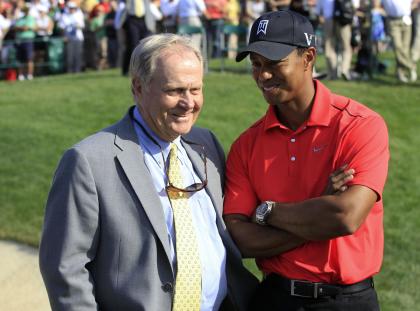Experts say injury won't keep Tiger Woods from returning to old form
Three months minimum of recovery are necessary, but Tiger Woods should eventually be able to return to his pre-injury level of competition, according to several doctors contacted by Yahoo Sports.
When the U.S. Open begins on Thursday, Woods obviously won't be anywhere near Pinehurst. This isn't exactly a surprise; Woods has missed six of the past 24 majors due to a bouquet of injuries.
With Tiger, the question has turned from "is he winning" to "is he even playing?"
For now and the foreseeable future, the answer remains "no." But there is hope on the horizon.
The backstory. In late March, Woods underwent a surgery known as a microdiscectomy. The procedure involves removing a tiny bit of bone that impacts a nerve, and is designed to relieve pain in the lower back and legs. For Woods, the pain had become so severe that he could no longer swing a golf club comfortably.

But how reliable is the procedure? And is a microdiscectomy simply a stopgap solution for a chronic problem?
Several doctors contacted by Yahoo Sports had potentially good news for Woods and his fans: Assuming there are no other complications, Woods should be back to his old form … eventually.
The key to Woods' recovery is whether the microdiscectomy addressed the source of his injury problems, or whether it only touched on one of many different symptoms.
"If the problem was just the nerve root impingement, the microdiscectomy could solve that problem," says Dr. David Geier, a Charleston, S.C., orthopedic surgeon and sports medicine specialist. "If someone already has degenerative conditions in their lower back, there could be problems down the road."
Woods is famously private, but gave one encouraging clue in a May blog entry. "One reassuring thing from my medical exam is I have zero arthritic changes whatsoever," Woods wrote. "I've kept myself in very good shape over the years, and it has paid off."
If that's the case, then, Woods has "only" to worry about recovery from this particular surgery.
That recovery in itself takes several stages.
"In general, with any athlete surgery, you begin with physical therapy of the muscles around the spine," says Dr. Andrew Hecht, a New York City spinal surgeon. "Once the athlete is comfortable with that, then they move on to sport-specific activities. Each athlete has a target point, a sweet spot, when they know when they're ready."
The doctors agreed that three months is the bare minimum for recovery time, meaning that Woods would not likely be ready for any competition before the end of June. This syncs up with what he's written so far about chipping and putting but not fully swinging, and it also means that being ready for the British Open in mid-July is a long shot at best.
The main concern for Woods returning to the course, then, isn't so much a recurrence of the original injury – the surgery addressed that – but rather a question of whether his core strength is sufficiently recovered.
"The twisting and rotation of the torso would be in high demand for a golfer of his level," Geier said. "I don't think the likelihood of a repeat problem is very high. There could be some discomfort and stiffness that could set him back, but it's unlikely that would be permanent."
"It's called 'micro'-discectomy, but it's still back surgery, and that's not nothing," says Dr. Derek Ochiai, an Arlington, Va., orthopedic surgeon. "From a strictly orthopedic standpoint, he should be healed from the actual surgery, and now he should be focused on the muscles around his back. The only real risk is if he pushes too quickly and those back muscles aren't ready."
The PGA Championship takes place a little more than four months after Woods' surgery. Woods won the 2000 PGA Championship at this year's host course, Valhalla, making it an appealing target for his return.
The larger question then becomes, does Woods have a chance at the greatest mark in golf? Woods remains roughly on pace with Jack Nicklaus for majors won; Woods is 38 with 14 majors. Nicklaus won his 15th major at age 38, and then his 16th and 17th at age 40. Nicklaus won his final major at age 46.
On one hand, the numbers still seem promising – that's more than 30 potential majors for Woods to win by the time he's 46. But consider the fact that only one guy has won even three majors in the past eight years: Padraig Harrington, who did it over the space of six majors in 2007-08.
Time may no longer be on Woods' side. But later this season, at least his back could be.
More U.S. Open coverage:
